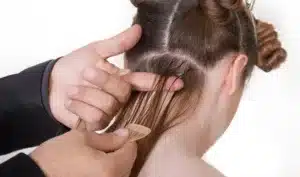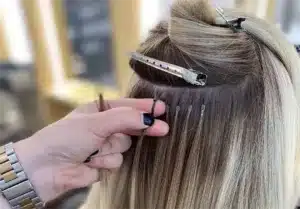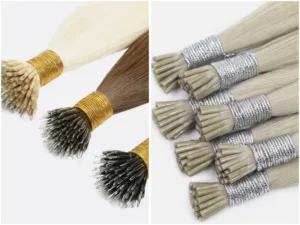Many salon owners and stylists have clients who ask, “Why did my tape-in extensions slip or lose beauty so quickly?” The truth is, tape-ins are one of the most popular and profitable extension methods, but their lifespan depends entirely on correct installation, high-quality hair, proper maintenance, and timely reapplication. Failing in any of these areas can lead to premature damage, extra costs, and unhappy customers.
The lifespan of tape-in extensions is determined by two factors. Firstly, the adhesive tapes need to be replaced and the extensions moved up every 6–8 weeks. Secondly, the longevity of the hair extensions themselves varies significantly, ranging from a couple of months to 1–2 years, depending on the quality of the hair purchased.
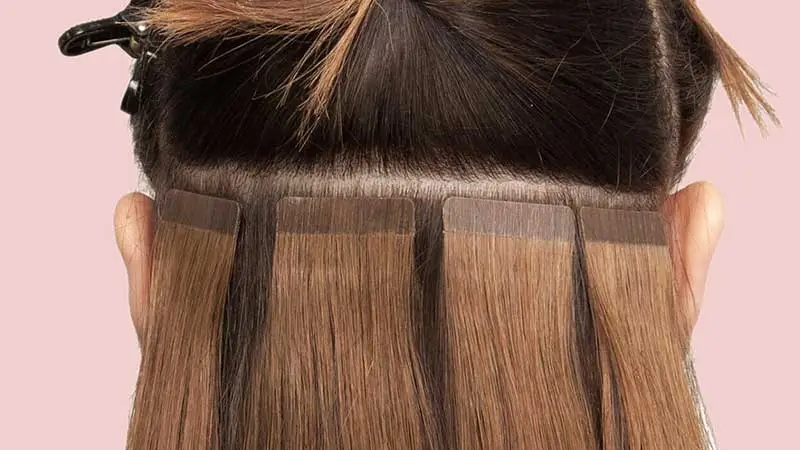
In this guide, you will learn exactly how long tape-in extensions can be worn before moving up, how long the hair itself should last, the factors that impact their lifespan, the professional care steps to extend wear time, and where to source tape-ins that truly stand up to repeated reuses.
How long can you leave tape extensions in?
Many clients think they can wear tape-ins for months without maintenance. In reality, this is one of the quickest ways to damage both the extensions and natural hair.
You should move up tape-in extensions every 6–8 weeks. This timing matches the average hair growth rate of 1–1.5 cm (0.4–0.6 inches) per month and ensures the tapes stay close to the scalp, maintain a natural appearance, and avoid strain on natural hair.
Why 6–8 weeks is the industry standard
- Hair growth displacement: As hair grows, the adhesive tabs shift downward, creating a gap between the scalp and the tapes.
- Tension imbalance: The further the tape moves from the scalp, the more leverage it has to pull on the root, leading to discomfort or breakage.
- Adhesive degradation: Oils, sweat, and styling products gradually weaken the bond.
- Hygiene and blending: Grown-out tapes become visible, harder to conceal, and can trap debris or product buildup.
Risks of delaying maintenance
| Problem | Cause | Result |
|---|---|---|
| Tangling at roots | Hair growth pushing adhesive away | Matting, difficulty during removal, possible breakage |
| Slipping extensions | Adhesive losing grip due to oil exposure | Extensions fall out unexpectedly |
| Root tension | Uneven weight distribution | Client discomfort, possible traction alopecia |
| Visible attachment | Gap between scalp and tape | Unnatural, less professional look |
Professional salons stick to a strict 6–8 week maintenance cycle to protect both the client’s investment and the stylist’s reputation.
How long should tape in extensions last?
When we talk about “how long they last,” we mean the total usable lifespan of the hair itself — across multiple reapplications — not just the time between move-ups.
The total lifespan depends on hair quality and aftercare discipline. Full cuticle hair extensions can last 12–24 months with proper care, Remy hair around 6–9 months, and non-Remy hair often just 2–4 months before losing their quality.
%[tape in extensions durability(https://placehold.co/600×400 “how long should tape in hair extensions last”)]
How hair grade impacts longevity
| Hair Grade | Average Lifespan | Key Characteristics |
|---|---|---|
| Full Cuticle Hair | 12–24 months | Single-donor, intact cuticles, aligned root-to-tip, soft, tangle-free |
| Remy Hair | 6–9 months | Cuticles aligned but partially processed, good blend |
| Non-Remy Hair | 2–4 months | Cuticles stripped, mixed directions, tangles easily |
Why care is just as important as quality
Even the best hair can be ruined by improper maintenance. Heat damage, rough brushing, or using harsh chemicals can strip the cuticle layer and shorten its life. Conversely, consistent gentle washing, conditioning, and avoiding unnecessary heat at the bonds keep hair smooth and reusable for many cycles.
Extensions are both a service and an investment. The longer they last, the more value your client receives — and the more repeat business your salon enjoys.
Caring for tape in hair extensions
Professional-grade tape-ins can be reused 3–6 times if cared for properly. Salons that provide detailed aftercare instructions see fewer complaints and higher client loyalty.
Step-by-step professional care guide
1.Washing routine
- Use only sulfate-free, extension-safe shampoo.
- Avoid scrubbing the scalp directly over the bonds — massage gently with fingertips.
- Wash 2–3 times a week to preserve natural oils and adhesive integrity.
2.Conditioning technique
- Apply conditioner from mid-lengths to ends only.
- Keep products away from adhesive tabs to avoid slippage.
- Use a leave-in conditioner or lightweight oil on ends for moisture.
3.Drying processe
- Pat hair with a towel; do not rub.
- Blow-dry the root area completely before sleeping to prevent bond breakdown.
- Keep blow dryer heat moderate when drying near tapes.
4.Brushing and detangling
- Use a loop brush or soft bristle brush designed for extensions.
- Hold roots with one hand and detangle from ends upward.
- Brush several times a day to prevent matting.
5.Styling guidelines
- Keep hot tools away from adhesive bonds.
- Use heat protectant on mid-lengths and ends before styling.
- Avoid tight hairstyles that pull directly on the tapes.
6.Sleeping habits
- Braid or tie hair loosely into a low ponytail before bed.
- Use a silk pillowcase to reduce friction.
7.Swimming and sports
- Apply leave-in conditioner before swimming to create a barrier.
- Wear hair in a braid or bun in chlorinated or saltwater.
- Rinse immediately afterward to remove chemicals or salt.
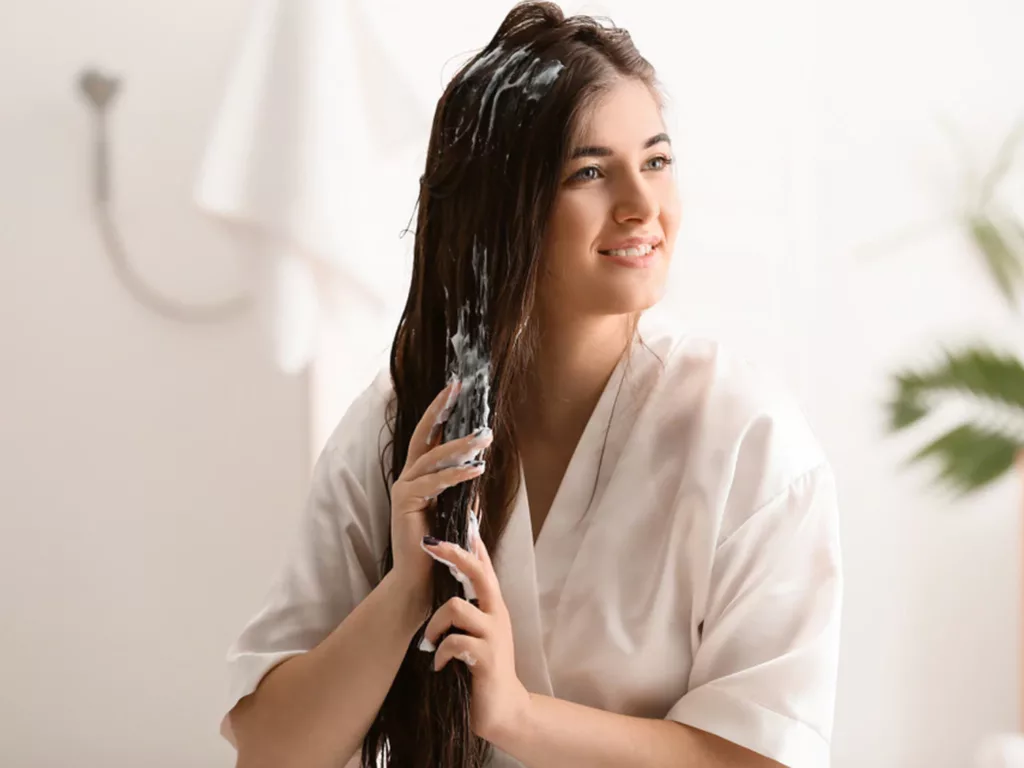
Where to buy long-lasting tape hair extensions
The quality of your supplier determines not only the look but also the profitability of your tape-in services.
What to demand from your supplier
- Full cuticle, single-donor hair for maximum durability and reusability
- Medical-grade adhesive that withstands salon washing and client styling
- Consistent color batches for repeat orders
- Factory-direct quality control without middleman markups
- Custom lengths, weights, and colors for your client base
At Hibiscus Hair Manufacturer, we specialize in luxury-grade full cuticle tape-in hair. Each set is produced with strict cuticle preservation, consistent coloring, and high-strength adhesive for multiple reuses. Our products are designed for salons and brands that refuse to compromise on quality.
My Opinion
We have manufactured tape-in hair extensions for over 25years, supplying salons and brands in more than 60 countries. The most successful stylists I work with all have one thing in common — they never compromise on hair grade. Full cuticle tape-ins not only last longer but also deliver a better client experience, fewer complaints, and more reapplications per set. This means more profit per service and stronger client retention.

FAQ
Q: How many times can tape-in extensions be reused?
A: High-quality full cuticle hair can be reused 3–6 times with new adhesive.
Q: Do tape-in extensions damage natural hair?
A: When applied, maintained, and removed professionally, they cause no damage.
Q: Can I color tape-in extensions?
A: Yes, but only full cuticle hair should be colored, and always by a professional.
Q: What’s the main cause of tape-in slippage?
A: Oils, conditioner on the bonds, or poor installation technique.
Q: How can I make tape-ins last longer between reuses?
A: Follow proper care routines, avoid over-washing, and store correctly between uses.
Q: Which tape-ins are best for fine hair clients?
A: Single-sided tape or invisible tape for reduced bulk and more natural blending.
Q: Can clients swim or exercise with tape-ins?
A: Yes, but protective measures like braiding and immediate rinsing are essential.
Q: How long does it take to install tape-ins?
A: A full head typically takes 45–90 minutes depending on stylist speed.
Q: What adhesive should be used for tape-in extensions?
A: Professional-grade medical adhesive designed for hair extensions, safe for skin contact.
Q: How do you remove tape-in extensions safely?
A: Use an alcohol-based or oil-based remover to break down adhesive without pulling natural hair.
Q: Can tape-ins be combined with other extension methods?
A: Yes, hybrid installations can be done, but hair weight and tension must be balanced.
Conclusion
Tape-in extensions should be moved up every 6–8 weeks, but the hair itself can last 1–2 years when using full cuticle quality and following a strict care routine. Professional-grade sourcing and client education are the keys to long-lasting, profitable results.
where to buy wholesale tape hair extensions
Hibiscus Hair Manufacturer has been dedicated to producing high-quality tape in hair extensions for 25 years and is a recognized leader in the industry. If you are interested in finding a reliable hair extensions supplier and wholesale for your brand, please visit our website for more information:
TAPE IN HAIR

